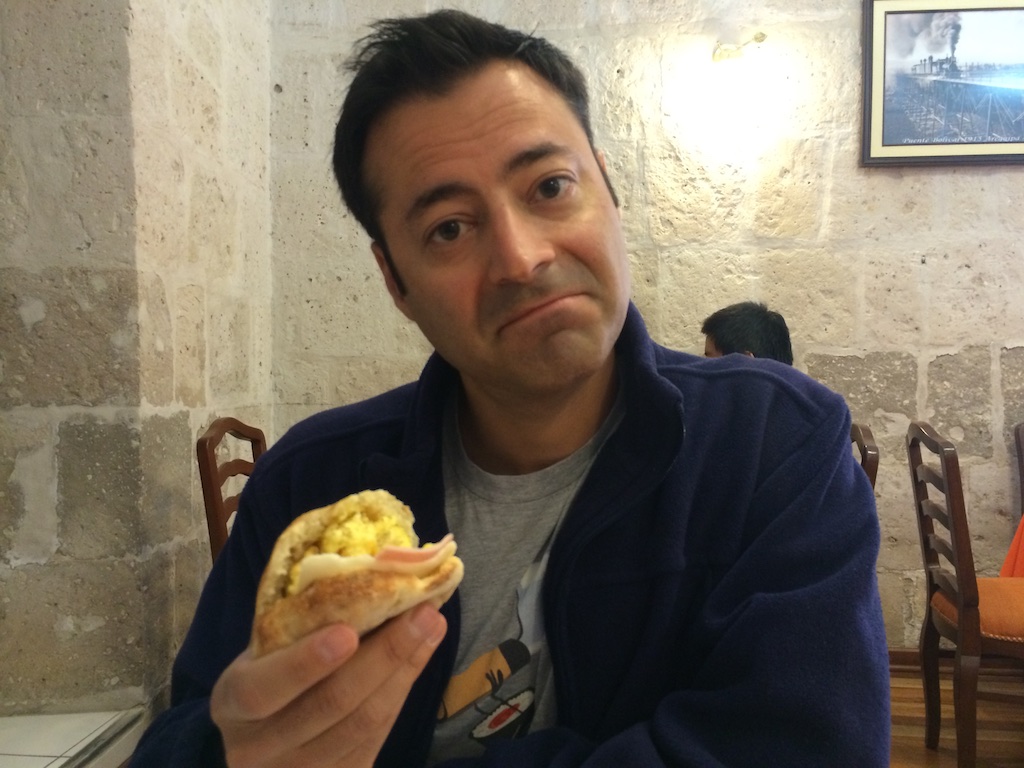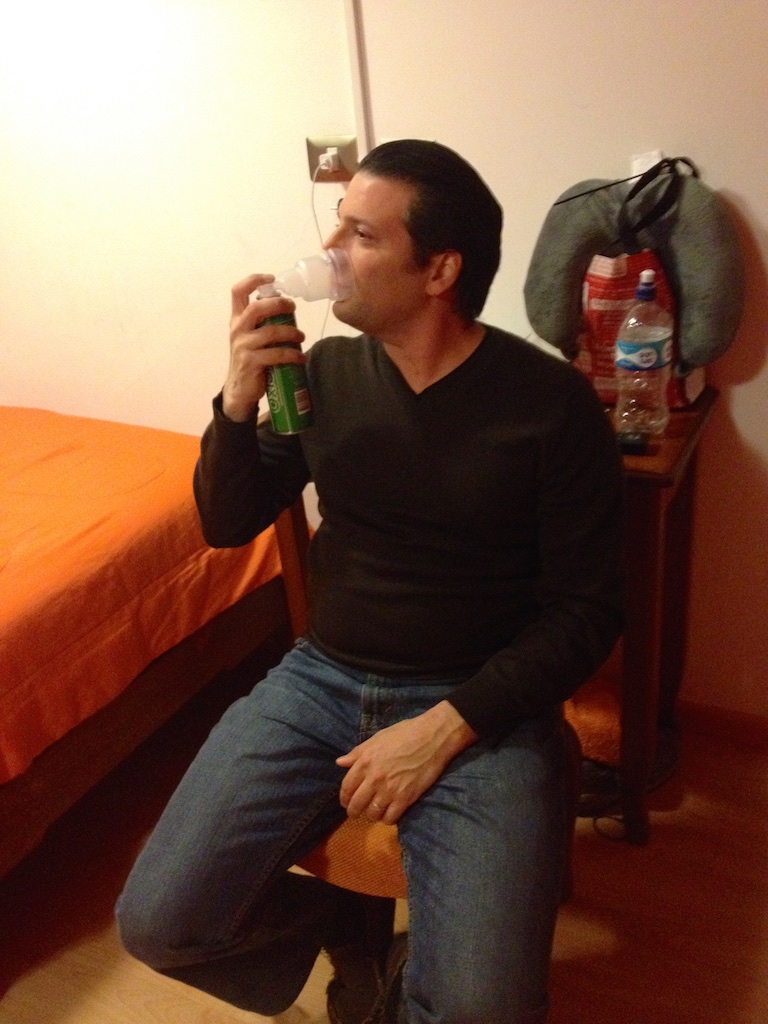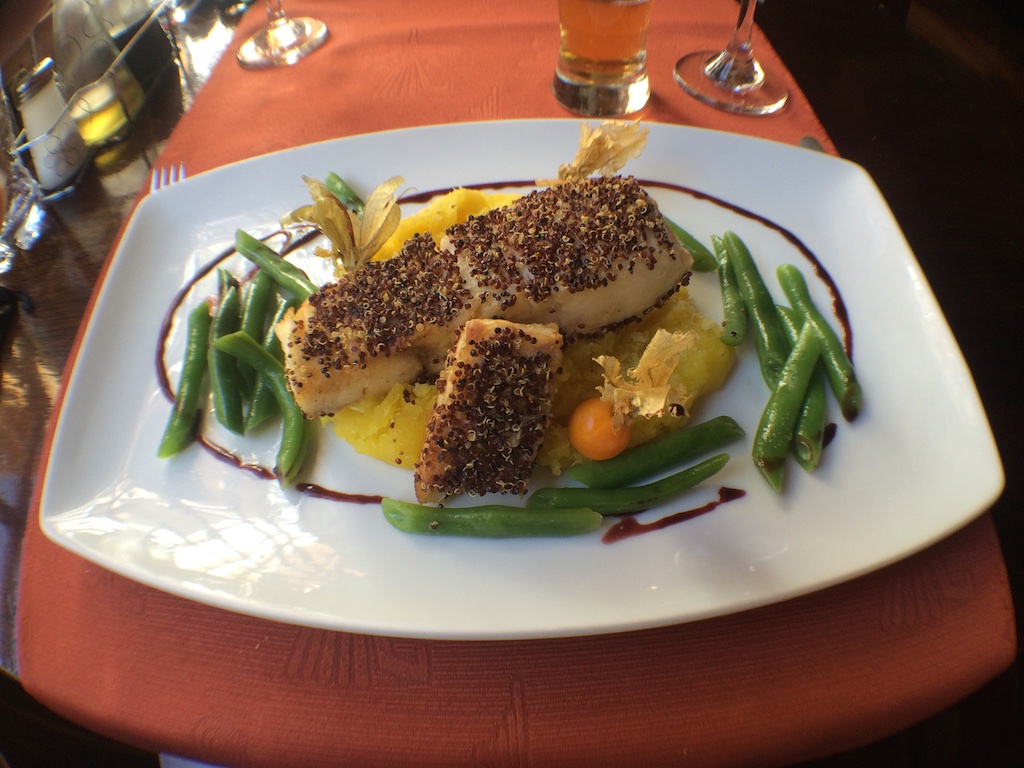
Ascending Arequipa
When I left you last on this Peruvian adventure I had just grabbed our handmade chocolate and was heading to the bus station. Ant and I had booked ourselves an overnight bus to Arequipa, Peru’s second largest city and the home of some of the countries most majestic peaks and canyons. Rather than fly we opted to use our sleep time to travel and booked ourselves on Cruz del Sur’s double decker sleeper bus. When booking, we upgraded ourselves the, $11US up charge, VIP seats. Although we only planned on sleeping on the $43US per seat trip, it seemed like a no brainer. We boarded the bus at 7:30pm and that’s the last thing that went right for the next 10 and a half hours.
I could write an entire post about this horrific bus ride and never once bash the bus operator. The problem, I would realize four hours later, and in a bleary half asleep state, would be blamed on the tough Peruvian landscape and roadway infrastructure. Before we move off this trip and start talking Arequipa lets take a quick look at the journey through hell (As I call it). Click on a few of those orange markers below to get a sense of the elevations this part of the world is infamous for.
Then take a closer look at that topography. The closer the lines the steeper the grade. So, I finally fall asleep about three hours into the trip because the “highway” the bus takes goes through a small Andes town every 20 minutes. Each time this happens speed bumps and stop signs bounce and slow the bus. That was part one of the nightmare along with us choosing the bottom of the bus thinking it would “rock” less. That theory holds water but what we didn’t realize is that there is a solid wall separating our seats from the driver. More importantly, separating us from the windshield. Think for a second about the last time you were in a road vehicle that you could not see out the front window…right, never. That doesn’t bode well with constant stop and go, bouncy bounce.
I finally managed to fall asleep for about an hour before I was jarred awake by a headache so intense that it felt like my brain grew two sizes. I looked at my watch (which has an altimeter) and it read 15,500ft. I struggled in and out of slumber fighting pain, nausea and dizziness until the sun came up 6 hours later. Luckily when we arrived in the hotel we were able to check in at 6:30am and head up to our room. I promptly hit the bed desperate for some real, motionless, sleep. I realized later that our bus had been up and down the mountain peaks all night reaching a 16,100ft pass at it’s highest point!
An explosive welcome to Arequipa
I woke with my altitude headache subdued. My growling stomach replaced my screaming brain and Ant and I headed out to find some lunch. Arequipa is known for it’s food almost as much as Lima but doesn’t get nearly the international notoriety.
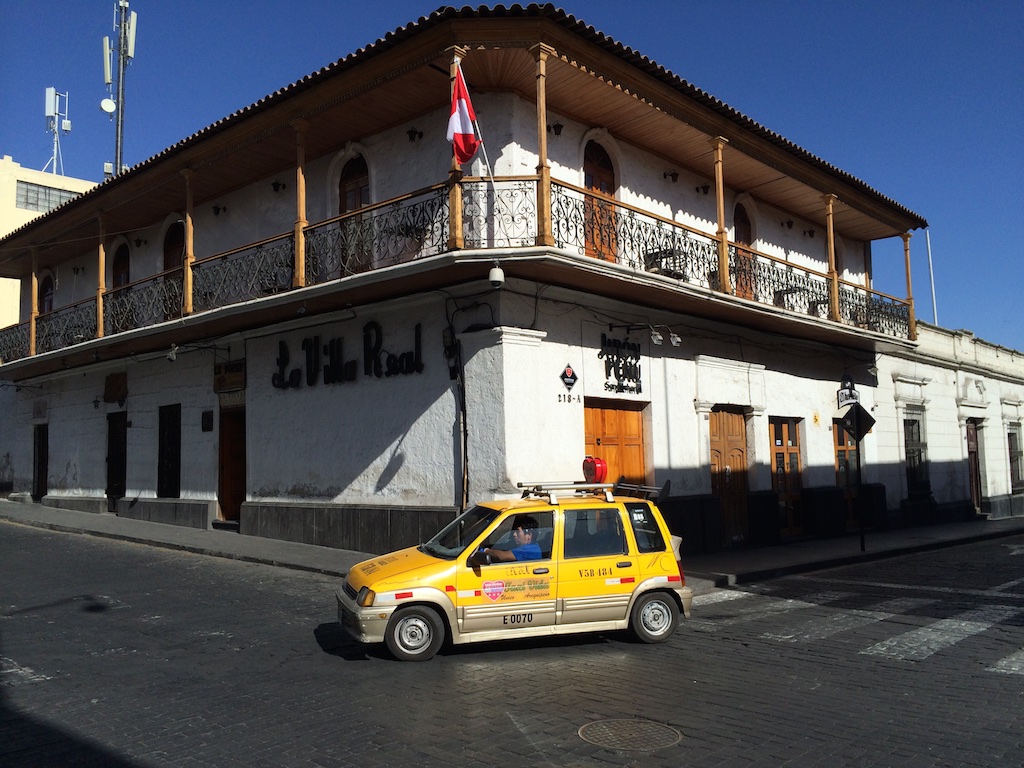 I’m not sure if it was the long ride or the extended sleep but Ant and I picked the best meal in Arequipa on our first shot. Our other dinners and lunches were great but nothing beat Zingaro. Just a few blocks from the main square, Plaza de Armas. We started with the traditional delicacy Chupe de Camarones, a concentrated broth made from shrimp head extract and accompanied by shrimp tails, dried red chili peppers, poached eggs, yellow potatoes, rice, fresh cheese, and milk.
I’m not sure if it was the long ride or the extended sleep but Ant and I picked the best meal in Arequipa on our first shot. Our other dinners and lunches were great but nothing beat Zingaro. Just a few blocks from the main square, Plaza de Armas. We started with the traditional delicacy Chupe de Camarones, a concentrated broth made from shrimp head extract and accompanied by shrimp tails, dried red chili peppers, poached eggs, yellow potatoes, rice, fresh cheese, and milk.
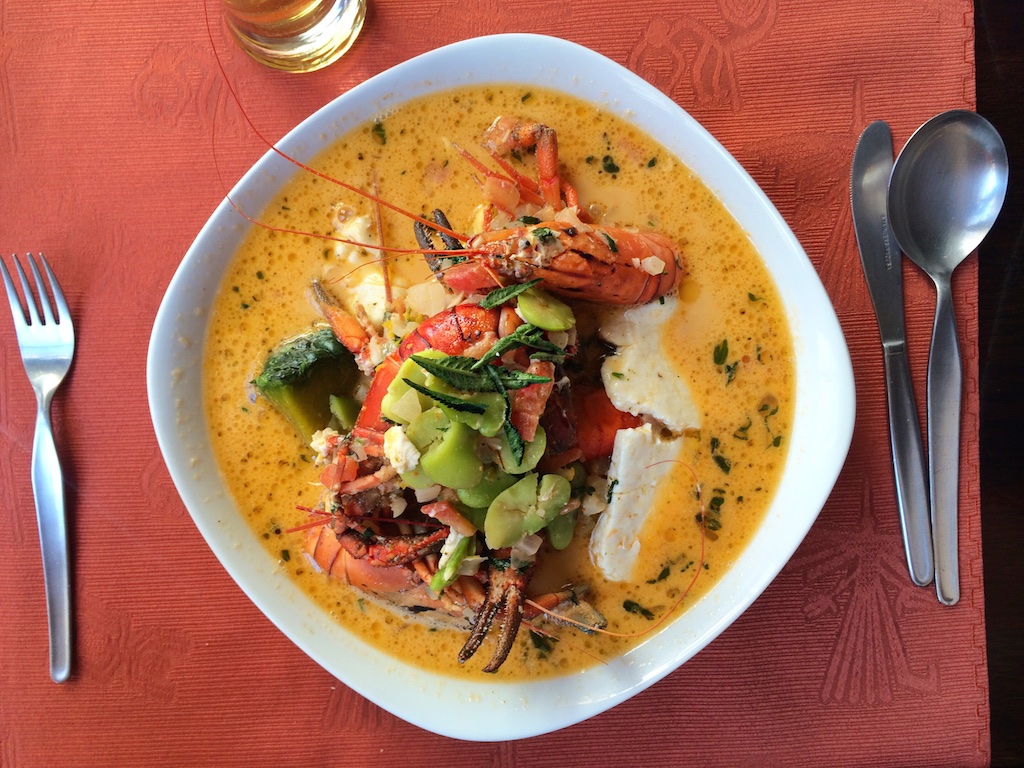 We followed that with Alpaca ribs and provencal sauce served with quinoa risotto in white wine.
We followed that with Alpaca ribs and provencal sauce served with quinoa risotto in white wine.
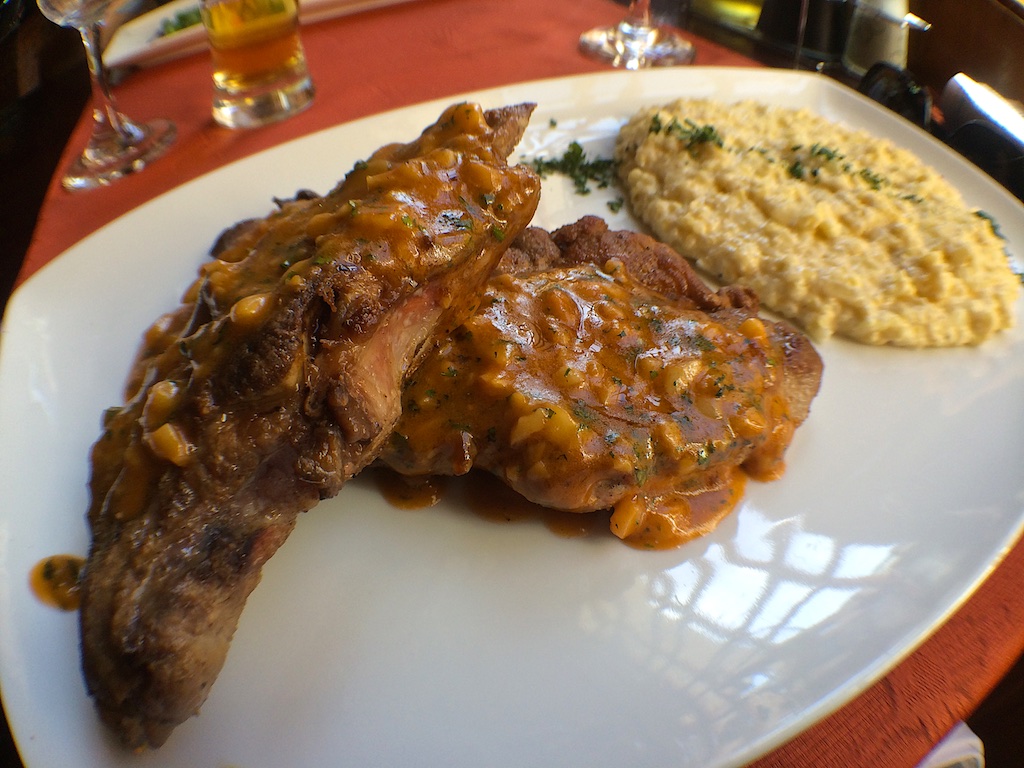 Trout is another Arequipa specialty but that would have to wait because there was a quinoa crusted paiche on the special menu. The paiche is native to the Amazon and are among the largest freshwater fish in the world. They can reach lengths of 15 ft and weigh in at over 400lbs. I don’t usually swipe pictures but I feel you need to understand how big this fish really is. Keep in mind it swims in freshwater rivers less than 10 ft. deep.
Trout is another Arequipa specialty but that would have to wait because there was a quinoa crusted paiche on the special menu. The paiche is native to the Amazon and are among the largest freshwater fish in the world. They can reach lengths of 15 ft and weigh in at over 400lbs. I don’t usually swipe pictures but I feel you need to understand how big this fish really is. Keep in mind it swims in freshwater rivers less than 10 ft. deep. 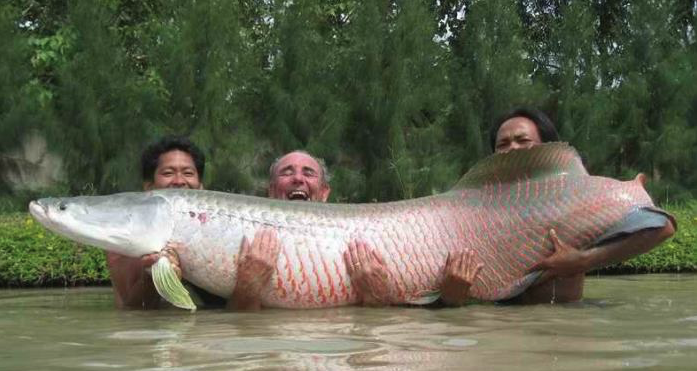 Photo credit DiveBuddy.com
Photo credit DiveBuddy.com
The Paiche hits the plate like a swordfish or a halibut. A very “steak” fish cut. This preparation came with the obligatory quinoa crust and sat on an amazing causa. Causa is a staple in Peruvian kitchens. It starts with small yellow potatoes found high in the Andes, which makes it “local” on my plate her in Arequipa. The potatoes are mashed and then mixed with corn and aji amarillo (yellow chile) paste along with vegetable oil, lime juice and salt to create what I can best describe as a pudding texture. In a true Causa you’d build layers that include meat, avocado and the “pudding” mixture. For this dish they sat the paiche on top of the sweet potato pudding and it worked as the perfect side for the succulent and firm fish.
 The rest of the day we spent casually exploring the town starting in Plaza de Armas.
The rest of the day we spent casually exploring the town starting in Plaza de Armas.
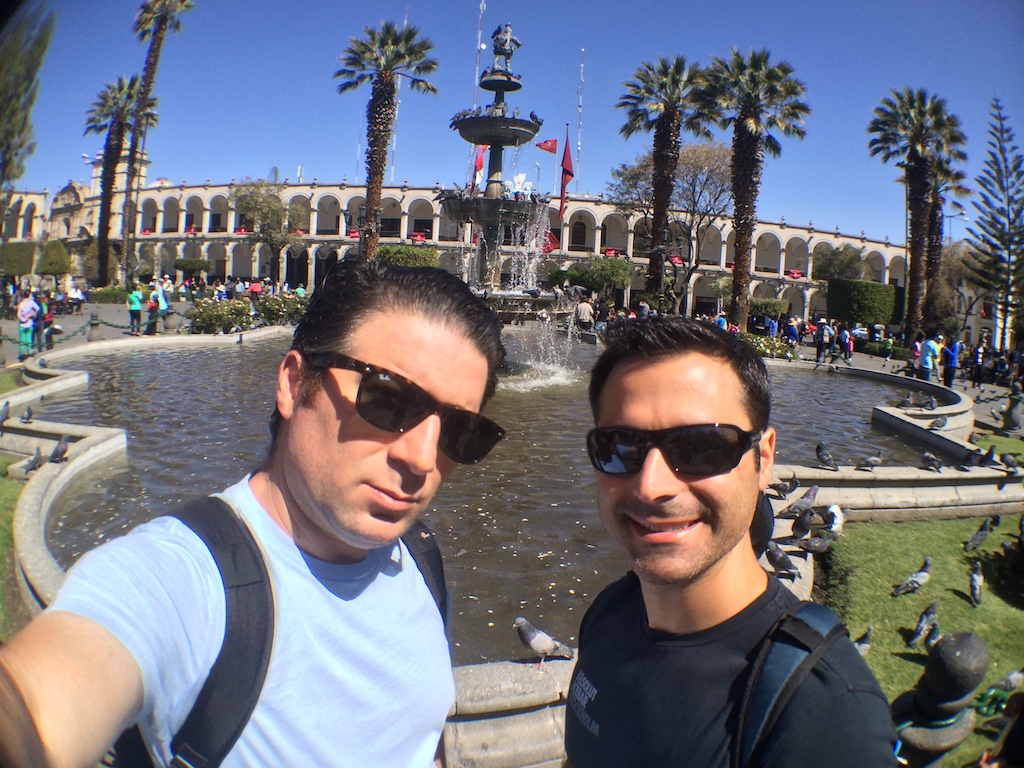 We spent some time in the labyrinth of Monasterio de Santa Catalina. The monastery was built in 1579 and was enlarged in the 17th century to be over 20,000 square meters. Here’s the ancient kitchen. Of course we found teh kitchen! Click it for a bigger image.
We spent some time in the labyrinth of Monasterio de Santa Catalina. The monastery was built in 1579 and was enlarged in the 17th century to be over 20,000 square meters. Here’s the ancient kitchen. Of course we found teh kitchen! Click it for a bigger image.
 We wandered into markets, coffee shops and tour guide kiosks all in the shadow of the three inactive volcanos Arequipa sits at the base of; Chachani, Misti and Ubinas (That one is still active actually but has not erupted in 40 years).
We wandered into markets, coffee shops and tour guide kiosks all in the shadow of the three inactive volcanos Arequipa sits at the base of; Chachani, Misti and Ubinas (That one is still active actually but has not erupted in 40 years).
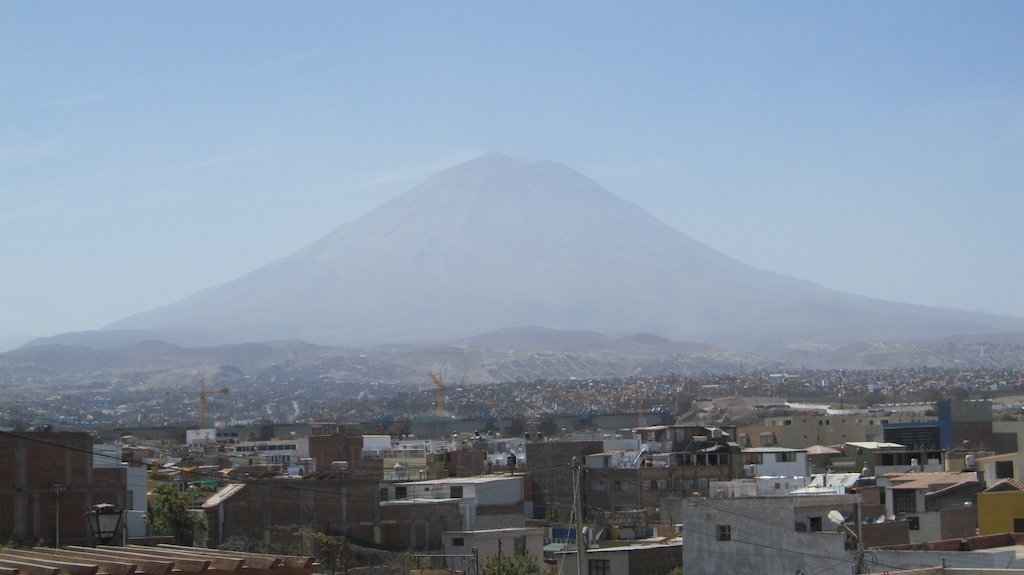
Downhill Deliberation
Originally we we’re headed to Colca Canyon, one of the deepest in the world. Turns out it’s a 5 hour drive back over the mountains and, frankly, even the sound of that gave me a headache after my intense bus ride debacle. We had started to feel the bite of Peruvian city-to-city travel. My running commentary on Peru is that it’s awesome but prepare for rough and tumble travel. Getting from place to place with the different altitudes and landscapes requires time, patience and audibles. Jungle, to mountains to coastal dessert might be the most extreme change in conditions I’ve had the pleasure to experience in such a short distance.
Given all that, we opted for a half day trip mountain biking down Chachani. Yes, the aforementioned volcano. Before the ride we decided to fuel up. All around Arequipa you’ll find tiny, set menu restaurants open for lunch. A funa nd interesting part of the local culinary scene. We wandered into one just down the road from where we needed to meet our biking guide. The menu was chaque, lentejita, arroz con pollo, atomatada and pescado frito. All for 6 Peruvian Sols. That’s under $2US. Confused, and with an enormous communication gap between the proprietor and us, he waved for us to take a seat. We found our way to a table in the back. Two old men sat at separate tables amongst the 8 to 10 that were in the room. We wound up with the soup and the chicken. Chaque is a soup which is very traditional of Arequipa and dates back to 1816 when the first Peruvian food recipes were published. The beef bone in it lent itself well to a flavorful broth but didn’t excite us as much as the chicken and rice.
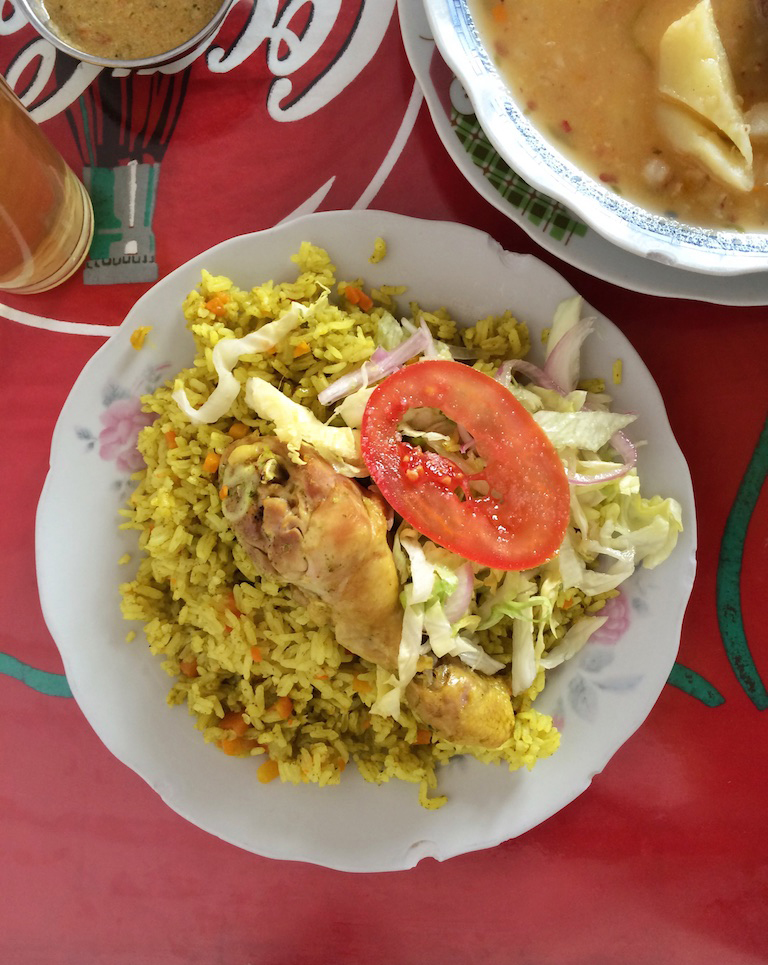 After we ate these two we signaled to pay which confused the old owner. I still don’t know what we were supposed to get for our 6 sols but we left a bewildered man in the doorway calling to us in quechua something about eating more. Which we only understood from his body language. I highly recommend this gastro-adventure if you’re in Arequipa. Pick a spot that looks good and tunnel inside, sometimes these spots are through a few doorways and down a couple halls. Look for the sandwich boards out on the street. That indicates the menu and where you can find the restaurant.
After we ate these two we signaled to pay which confused the old owner. I still don’t know what we were supposed to get for our 6 sols but we left a bewildered man in the doorway calling to us in quechua something about eating more. Which we only understood from his body language. I highly recommend this gastro-adventure if you’re in Arequipa. Pick a spot that looks good and tunnel inside, sometimes these spots are through a few doorways and down a couple halls. Look for the sandwich boards out on the street. That indicates the menu and where you can find the restaurant.
 Fifteen minutes later our guide was giving us the skinny as we bumped along the road up Chachani. The deal was this. We get driven near the top and ride down. The road we drive up is the main trail. The pavement runs out about half way up. If you want to “up” the experience there are some single track trails that cut across the road. Being an ex-Mountain bike die hard, I was psyched for it. I should have expected Peruvian single track but I didn’t. Which is to say, the trail was a wash. Deep ravines plagued the natural ride line which caused me to focus more on staying out of the gutter than riding the mountain. I even crashed once and needed a repair. I blame the mountain but could be taht I haven’t seen single track since 2005. (grumble)
Fifteen minutes later our guide was giving us the skinny as we bumped along the road up Chachani. The deal was this. We get driven near the top and ride down. The road we drive up is the main trail. The pavement runs out about half way up. If you want to “up” the experience there are some single track trails that cut across the road. Being an ex-Mountain bike die hard, I was psyched for it. I should have expected Peruvian single track but I didn’t. Which is to say, the trail was a wash. Deep ravines plagued the natural ride line which caused me to focus more on staying out of the gutter than riding the mountain. I even crashed once and needed a repair. I blame the mountain but could be taht I haven’t seen single track since 2005. (grumble)
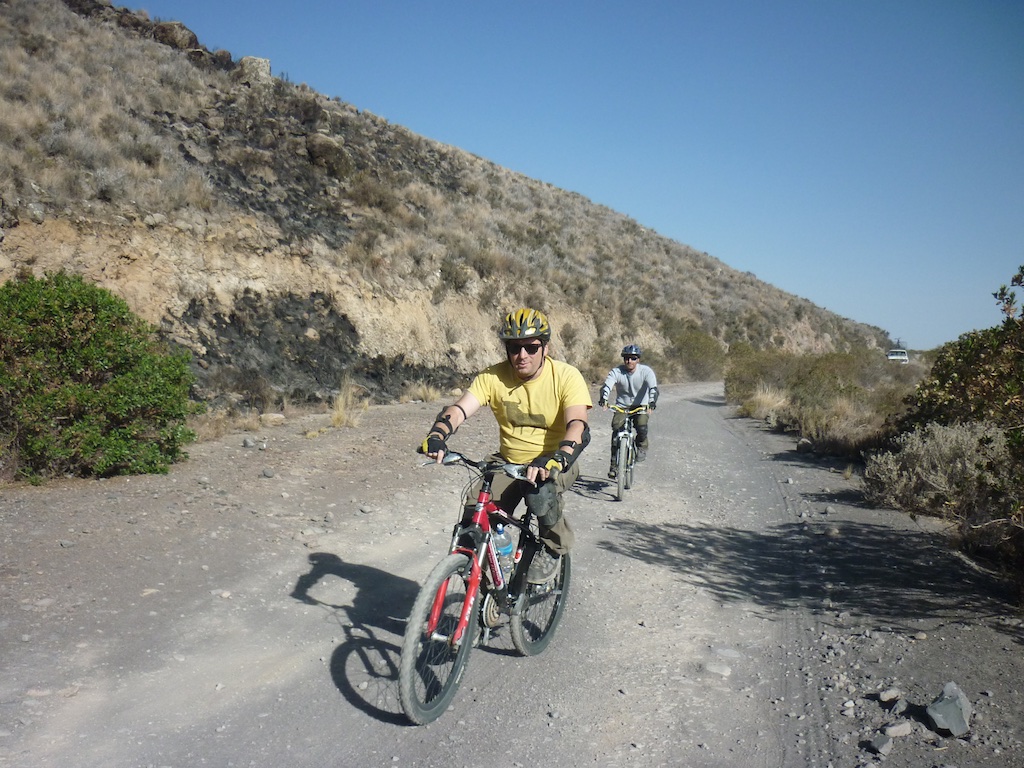
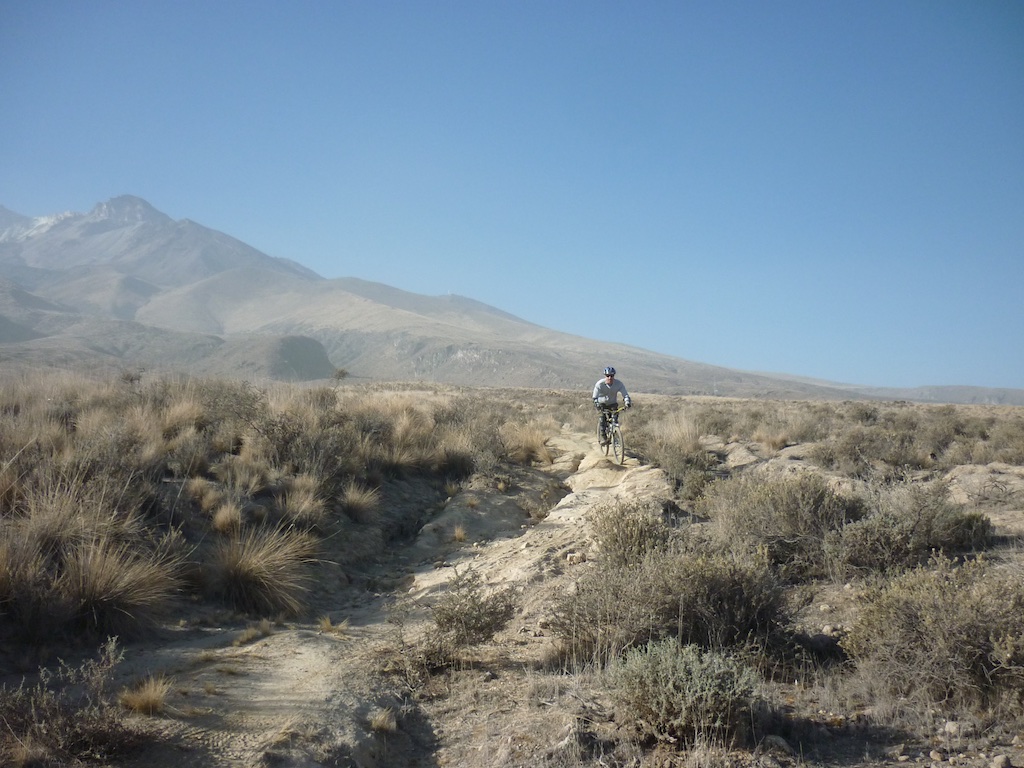
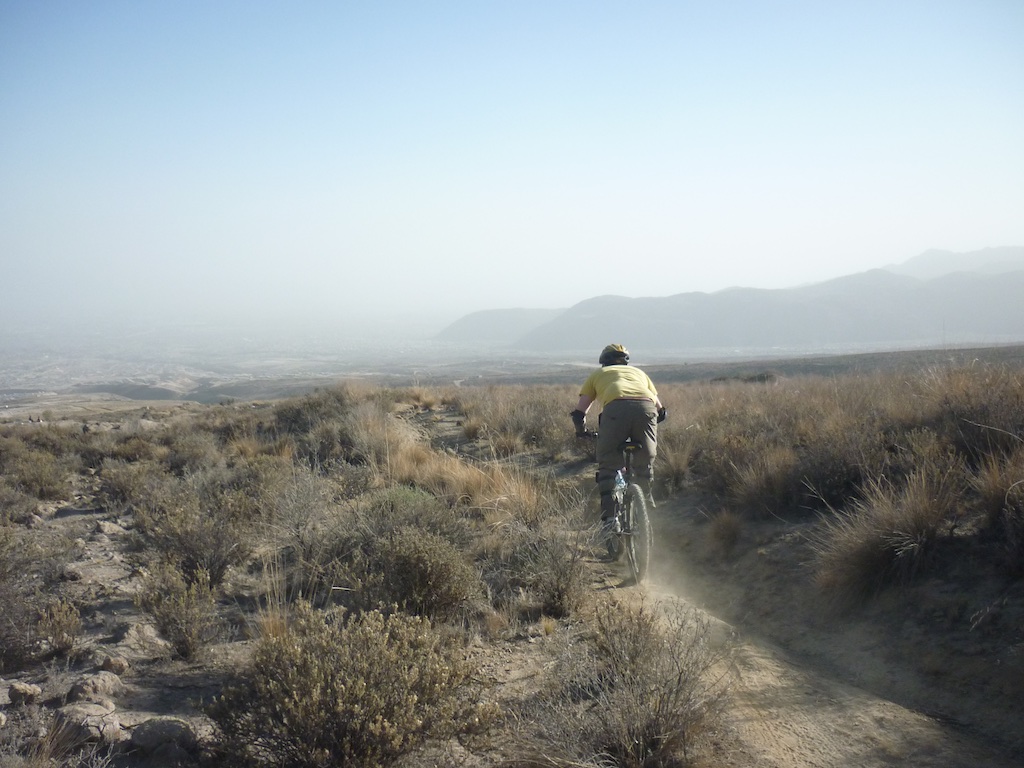 Just before the pavement started we took the last shortcut. This time it wasn’t single track. It was wider than the trail and even the road. It passed directly through a shanty town. As we learned, these non-residents started living just out of the city limits to avoid taxes and laws. There is no running water and electricity via generator only. Trash is gathered and dumped up the mountain off the side of the road. The squatters have built houses and huts gathered in communal clusters. Much like the slums I visited in India, they used a myriad of materials, mostly found objects, to construct these shelters. As we passed through we didn’t see many people but our guide said more than 1000 people live there. Their absence was due to the time of day. Most of them work down within the city limits and travel to and from each day. In recent months Arequipa authorities have tried to crack down on this growing problem but there is little they can do without changing laws or moving the city limits.
Just before the pavement started we took the last shortcut. This time it wasn’t single track. It was wider than the trail and even the road. It passed directly through a shanty town. As we learned, these non-residents started living just out of the city limits to avoid taxes and laws. There is no running water and electricity via generator only. Trash is gathered and dumped up the mountain off the side of the road. The squatters have built houses and huts gathered in communal clusters. Much like the slums I visited in India, they used a myriad of materials, mostly found objects, to construct these shelters. As we passed through we didn’t see many people but our guide said more than 1000 people live there. Their absence was due to the time of day. Most of them work down within the city limits and travel to and from each day. In recent months Arequipa authorities have tried to crack down on this growing problem but there is little they can do without changing laws or moving the city limits.
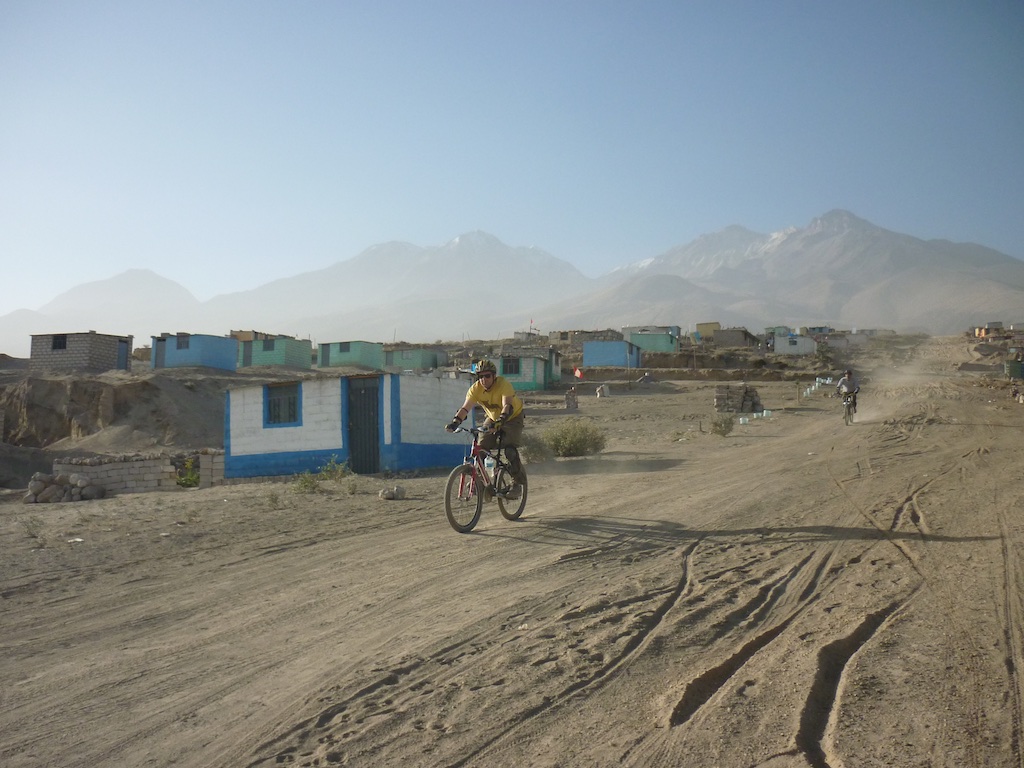 Back on the pavement the most treacherous part of the ride began. Ant and I call it “Dog Bowling”. There’s a 2 mile stretch of road as you cross into the city limits that’s riddled with stray dogs. These canines like to play a game of chase. Warned by our guide, the dogs lurch from their shaded, dirt beds and sprint up to the passing cyclist in full bark, teeth and all. Frightening as hell if you don’t expect it. The last time I had three dogs aggressively barking at me while in full sprint was as a paper boy back in 1986. The trick to their retreat is a bit different than my paperboy mace move. He gave us a two prong approach. Step one, ignore them and keep riding. That’s where the idea of bowling came to us. If they don’t retreat get aggressive by yelling “go away” directly at them and showing your teeth. This was surprisingly effective but still a bit unnerving.
Back on the pavement the most treacherous part of the ride began. Ant and I call it “Dog Bowling”. There’s a 2 mile stretch of road as you cross into the city limits that’s riddled with stray dogs. These canines like to play a game of chase. Warned by our guide, the dogs lurch from their shaded, dirt beds and sprint up to the passing cyclist in full bark, teeth and all. Frightening as hell if you don’t expect it. The last time I had three dogs aggressively barking at me while in full sprint was as a paper boy back in 1986. The trick to their retreat is a bit different than my paperboy mace move. He gave us a two prong approach. Step one, ignore them and keep riding. That’s where the idea of bowling came to us. If they don’t retreat get aggressive by yelling “go away” directly at them and showing your teeth. This was surprisingly effective but still a bit unnerving.
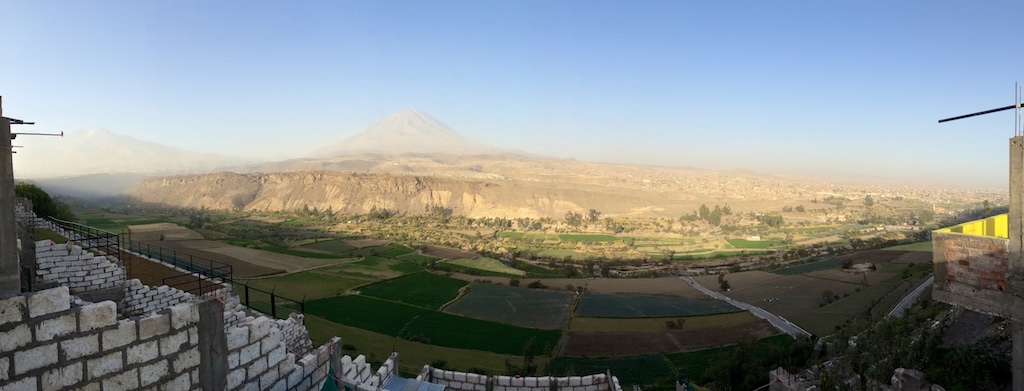 Eventually we made it back to our guides base camp and dropped the bikes before getting driven back into town. We heading back to the hotel to wash up and then went to find our dinner spot. ZigZag was another great meal that left us with sizzling plates of a variety of meats, indicated by cute flags placed on each, and a table side flaming dessert in the best way possible.
Eventually we made it back to our guides base camp and dropped the bikes before getting driven back into town. We heading back to the hotel to wash up and then went to find our dinner spot. ZigZag was another great meal that left us with sizzling plates of a variety of meats, indicated by cute flags placed on each, and a table side flaming dessert in the best way possible.
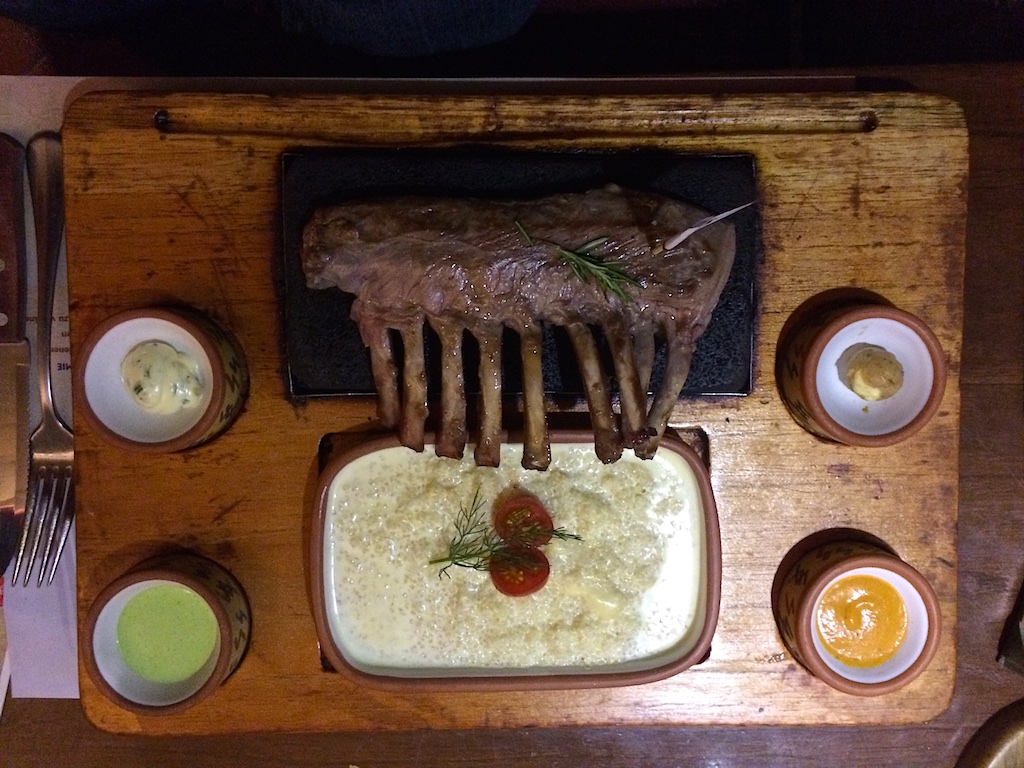


The next morning we flew back to Lima but not before Ant hustled together a sandwich of buffet items for breakfast and I feasted on supplemental oxygen. Not that I needed it anymore. It would have come in handy at the beginning of this story but because you can by O2 in any pharmacy, I thought it had to be done.
